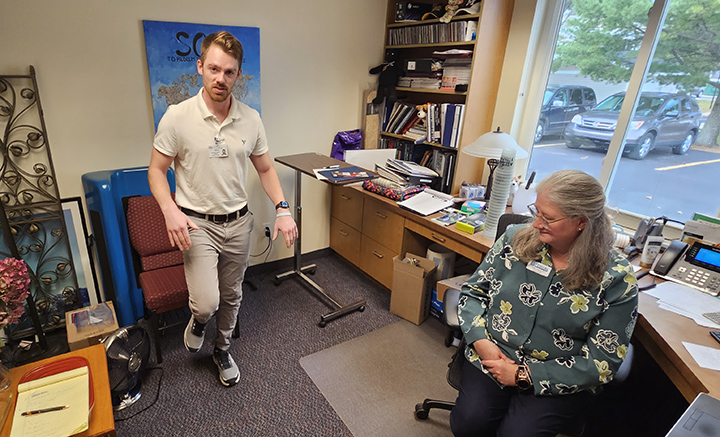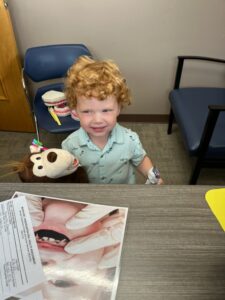Physical therapists offer tips to lessen fall risks

News Photo by Mike Gonzalez Brandon Hauff, left, a Central Michigan University student studying physical therapy with Thunder Bay FYZICAL Therapy, on Monday demonstrates a balancing technique used for physical therapy patients as Teresa Duncan, physical therapist and clinical director of Thunder Bay FYZICAL Therapy, watches.
ALPENA — A study published by the Journal of the American Geriatrics Society observed a decreased likelihood of older individuals falling when they use hearing aids consistently.
The study, released this summer, analyzed 299 surveys of individuals 60 and older with bilateral hearing loss and found that the odds of falling for hearing aid users dropped by 50% compared to those who do not utilize the hearing device.
Brandon Hauff, a Central Michigan University student working with Alpena’s Thunder Bay FYZICAL Therapy as a training physical therapist, said that, while he is not familiar with the effects of hearing aids and balance, he understands how the devices might be helpful.
“It makes sense that they’re kind of related, because there’s an organ in our ears called the vestibular system,” Hauff said. “It kind of tells us where our brain is in space and where we are. Also, there’s the vestibulocochlear nerve, and the cochlear nerve is the portion for hearing. Those nerves actually run together, and they come out of the ear to the brain. So them being so close together, it doesn’t surprise me that the effect on one can have an effect on the other.”
Hauff said other key points affect a person’s balance: their vision and their proprioception, which is the sense of body position and self-movement in the joints.
He said that patients usually say they feel most unstable when it’s night and dark, which is a time when people can’t see where they are as well. Hauff recommended night lights in the hallway or wherever people might need them to prevent falls.
Teresa Duncan, physical therapist and clinical director of Thunder Bay FYZICAL Therapy, said a good way to decrease any late-night falls is to remove fall risks such as rugs that catch on people’s feet and to add safety bars around the bathroom.
“There are a lot of increased falls at night, like Brandon said, and when people are rushing to get to the bathroom,” Duncan said. “You’re in a hurry and we tend to fall. Shoe wear was the other risk. So often, people want to wear slip-on shoes because they can’t reach their feet to put the shoes on, but slip-ons become a trip hazard.”
Hauff said that, if someone has fallen and requires physical therapy for balancing, hip muscles are a very important area to improve, as well as practicing balancing strategies.
“Let’s say you’re standing on one leg as a balance strategy, for example,” Hauff said. “If you’re not comfortable standing on one leg, and you’re showing a lot of instability, we’ll move to what we call standing with tandem, which is just one foot in front of the other. And then, if that’s too difficult, we can move to a semi-tandem, which is one foot halfway in front of the other foot.”
He said the best way to improve muscles is in a safe and controlled environment, particularly with an assistive device called a gait belt.
The gait belt, Duncan said, gives people a better feeling of comfort and safety because physical therapists are able to hold a handle on the belt that supports the wearer.
“Their world gets smaller and smaller,” Duncan said. “When we’re younger and somebody bumps into us, we react by taking a big step out to the side and we save ourselves. Someone who has fallen or doesn’t have those balancing reactions anymore can’t react, and they get fearful. And so they do less and less, you know, they restrict going out in public, they maybe rely on holding things as they go through the home.
“Like Brandon was saying, if you’re only working on what you can already do, it’s not going to expand your boundaries,” she continued. “You have to work on challenging yourself, which can be very scary to do, so that’s where we really tried to provide a safe environment.”





